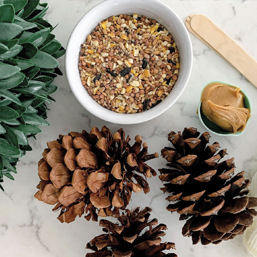
Educators, families and caregivers… bundle up! Whether you enjoy winter or not, it’s time to embrace the snow and cold because this season comes with a ton of learning opportunities for children. From wildlife, to adaptations, to temperature changes and more – with curious children by my side, I have learned to love this season for what it has to offer. Here are some of our favorite scientific activities to explore in nature during the months of December to March!
A nature scavenger hunt is an active way to encourage children to look closely at how the world changes during the winter. There are lots of these readily available online and a quick Google search will find one that’s age appropriate for your littles. I especially love the visual version from @angelateachingmama on Instagram because it encourages kids to use their five senses when they are exploring their natural world. From years of teaching, I have noticed that when children are asked to slow down and look, listen, touch and feel, it develops their ability to ask good scientific questions, expands their vocabulary and even impacts their creative writing. While your kids are engaging in the hunt, prompt them with questions like ”have you ever noticed the way that icicles form?”, “I wonder why pinecones are closed up so tight in the winter?”, or “hey! Look how long your shadow is today!”
Now that you’ve gathered some nature items (pinecones, rocks, twigs, berries or leaves for example), this one will be easy. We love creating frozen nature sculptures using muffin tins or cake pans and filling them with water and our newfound treasures. Set the pans outside overnight and wake up the next morning to a beautiful child-made ice sculpture. You can also make these sculptures by filling balloons, and we’ve even used two cups of different sizes stacked inside of each other to create ice lanterns (see picture). My kids love trying to free the nature objects or observing how their creations change overtime as the ice melts.
Backyard bird feeders are one of the easiest ways to integrate observation skills and care for animals into your winter activities. And the best part? Since new birds come and go all season, birdwatching doesn’t really get boring like some other winter activities. Whether it’s chickadees or magpies, blue jays or woodpeckers, watching these beautiful winged creatures visit, and maybe even live in your backyard, is so exciting for kids. You can purchase feeders at your local department store or on Amazon, but we love creating our own using nature or recycled materials. Our favorite is a simple peanut butter and seed feeder using cardboard shapes or a pinecone. To extend this activity, have blank paper, a pencil and binoculars readily available and encourage children to record their observations over the season. They can even enter a citizen science program in your area where they can help with local bird monitoring and become little nature activists!
Want to explore art outside this winter? Snow spray is super easy to make and encourages kids to get creative while they are outside playing in the snow. We buy spray bottles from the dollar store for under $3 each and fill them with water and a few drops of food coloring. Take them outside and experiment with abstract art, color mixing and more!
Finally, who doesn’t like when scientific explorations lead to a sweet treat? Making maple taffy is the perfect way to spend an afternoon. Pack a layer of snow tight into a rimmed baking tray and place it outside (assuming it’s below zero, use your freezer if not). Meanwhile, take 1½ cups of pure maple syrup and bring to a boil in a small pot, until a candy thermometer reads 240 degrees Fahrenheit. Cool for about five minutes, and then drizzle in six lines on the snow filled baking tray. Let sit for 30 seconds, then place a popsicle stick at one end, and roll up the taffy around the stick. Enjoy immediately. Making this taffy is so fun, with delicious results for your children, but remember they will need lots of adult support for this one, as it does involve the stove top.
The possibilities for scientific exploration during this frosty time of the year are endless, and the more exposure children have to the great outdoors in the cooler months, the more they will learn to love and appreciate it too. Not to mention, exploring nature in general allows children to develop skills like empathy, environmental stewardship, problem solving skills and curiosity. For more of our favorite winter activities, be sure to follow me @teachthemlittle on Instagram and Facebook!
Ashley is a mom of three, Early Childhood Educator, and Elementary Teacher. She has a Master’s Degree (Instructional Leadership) from the University of Calgary and loves inspiring families, educators, and caregivers to help their children learn at home and at school. For more ideas, follow her on Facebook and Instagram @teachthemlittle.
See our related articles:
Calgary’s Child Magazine © 2024 Calgary’s Child